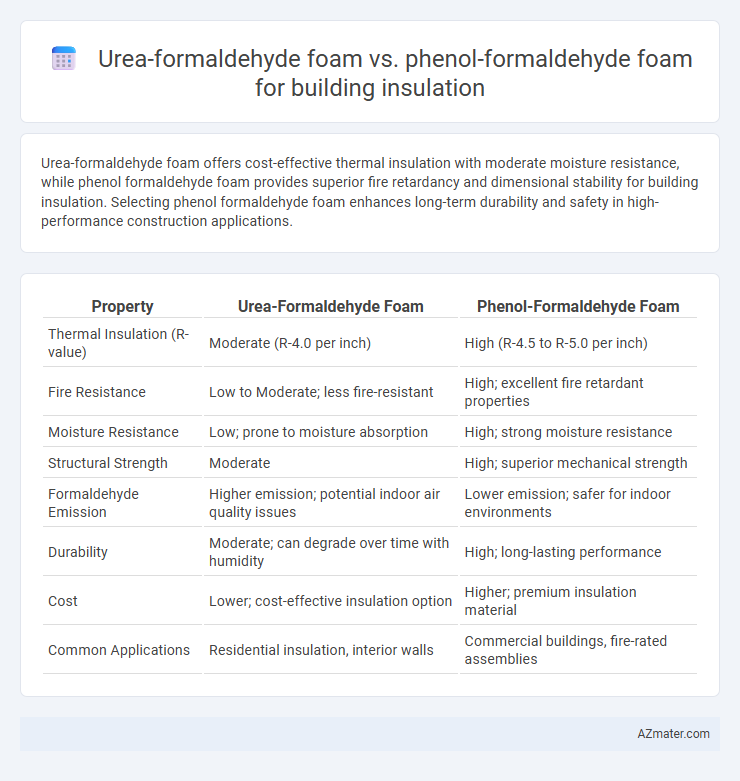Urea-formaldehyde foam offers cost-effective thermal insulation with moderate moisture resistance, while phenol formaldehyde foam provides superior fire retardancy and dimensional stability for building insulation. Selecting phenol formaldehyde foam enhances long-term durability and safety in high-performance construction applications.
Table of Comparison
| Property | Urea-Formaldehyde Foam | Phenol-Formaldehyde Foam |
|---|---|---|
| Thermal Insulation (R-value) | Moderate (R-4.0 per inch) | High (R-4.5 to R-5.0 per inch) |
| Fire Resistance | Low to Moderate; less fire-resistant | High; excellent fire retardant properties |
| Moisture Resistance | Low; prone to moisture absorption | High; strong moisture resistance |
| Structural Strength | Moderate | High; superior mechanical strength |
| Formaldehyde Emission | Higher emission; potential indoor air quality issues | Lower emission; safer for indoor environments |
| Durability | Moderate; can degrade over time with humidity | High; long-lasting performance |
| Cost | Lower; cost-effective insulation option | Higher; premium insulation material |
| Common Applications | Residential insulation, interior walls | Commercial buildings, fire-rated assemblies |
Introduction to Urea-Formaldehyde and Phenol Formaldehyde Foams
Urea-formaldehyde foam is a widely used insulation material characterized by its cost-effectiveness, good thermal resistance (R-value around 4.4 per inch), and ease of installation in wall cavities. Phenol formaldehyde foam offers superior fire resistance, low smoke emission, and excellent dimensional stability, making it ideal for applications requiring stringent fire safety standards. Both foams are thermosetting polymers formed by the chemical reaction of urea or phenol with formaldehyde, providing rigid, closed-cell structures that enhance energy efficiency in buildings.
Chemical Composition and Manufacturing Processes
Urea-formaldehyde foam insulation is produced through the polymerization of urea and formaldehyde resins, resulting in a nitrogen-rich, thermosetting polymer with a dense cellular structure. Phenol-formaldehyde foam, synthesized from phenol and formaldehyde, forms a highly cross-linked phenolic polymer known for superior thermal stability and fire resistance. Manufacturing of urea-formaldehyde foam involves a hot or cold curing process with rapid foam expansion, whereas phenol-formaldehyde foam requires more controlled condensation reactions and curing to achieve its rigid, chemically resistant structure.
Thermal Insulation Performance Comparison
Urea-formaldehyde foam exhibits a thermal conductivity typically around 0.035-0.045 W/m*K, making it effective for residential insulation but slightly less efficient than phenol formaldehyde foam, which generally ranges between 0.020-0.028 W/m*K. Phenol formaldehyde foam offers superior thermal insulation due to its lower thermal conductivity and enhanced fire resistance, contributing to better energy efficiency in buildings. The higher R-value per inch of phenol formaldehyde foam provides improved temperature regulation and reduced heat transfer compared to urea-formaldehyde alternatives.
Fire Resistance and Safety Considerations
Urea-formaldehyde foam insulation exhibits lower fire resistance compared to phenol-formaldehyde foam, making the latter a superior choice for enhanced safety in building applications. Phenol-formaldehyde foam offers excellent flame retardant properties and produces less toxic smoke during combustion, which significantly reduces fire hazards. Fire safety regulations often favor phenol-formaldehyde due to its stability and low flammability, critical factors in occupant protection and building code compliance.
Durability and Longevity in Building Applications
Urea-formaldehyde foam insulation tends to have lower durability compared to phenol-formaldehyde foam, as it is more prone to moisture absorption and degradation over time. Phenol-formaldehyde foam exhibits superior longevity due to its enhanced chemical stability, moisture resistance, and structural integrity in building insulation applications. This makes phenol-formaldehyde foam a preferred choice for long-term performance and durability in harsh environmental conditions.
Environmental Impact and Sustainability
Urea-formaldehyde foam insulation (UFFI) typically releases low levels of formaldehyde gas, which can contribute to indoor air pollution and poses health risks, whereas phenol-formaldehyde foam exhibits superior chemical stability with minimal off-gassing, enhancing indoor air quality. Phenol-formaldehyde foams are biobased and provide higher durability and resistance to degradation, translating to longer service life and reduced environmental waste compared to UFFI, which degrades faster and can release harmful emissions during aging. The production of phenol-formaldehyde foam generally consumes less energy and results in lower greenhouse gas emissions, supporting better sustainability profiles aligned with green building standards and LEED certification.
Indoor Air Quality and Emissions
Urea-formaldehyde foam insulation (UFFI) tends to release higher levels of formaldehyde emissions compared to phenol formaldehyde foam, which can negatively impact indoor air quality and increase health risks over time. Phenol formaldehyde foam exhibits superior chemical stability and lower off-gassing rates, making it a safer choice for minimizing indoor pollutants. Selecting phenol formaldehyde foam insulation contributes to improved indoor air quality by reducing volatile organic compound (VOC) emissions commonly associated with urea-formaldehyde products.
Cost Analysis: Upfront and Lifecycle
Urea-formaldehyde foam typically offers lower upfront costs compared to phenol formaldehyde foam, making it a budget-friendly option for initial insulation installation. However, phenol formaldehyde foam displays superior durability and resistance to moisture and thermal degradation, which can lead to lower lifecycle maintenance and replacement expenses. Lifecycle cost analysis often favors phenol formaldehyde foam in long-term building insulation projects due to its enhanced longevity and energy efficiency performance.
Installation Methods and Practical Considerations
Urea-formaldehyde foam insulation is typically installed via a two-component spray system requiring careful mixing and quick application to avoid off-ratio problems, making it suitable for smaller or segmented spaces. Phenol formaldehyde foam uses a similar spray-applied method but offers superior fire resistance and dimensional stability, often preferred in commercial or high-performance building projects. Practical considerations include the higher formaldehyde emissions of urea-formaldehyde foam compared to the lower emission and longer durability of phenol formaldehyde foam, influencing ventilation needs and long-term maintenance.
Choosing the Right Foam for Specific Building Needs
Urea-formaldehyde foam offers excellent thermal insulation and is cost-effective, making it suitable for interior wall cavities in residential buildings with moderate humidity. Phenol formaldehyde foam provides superior fire resistance and dimensional stability, ideal for commercial structures or areas requiring stringent fire codes and long-term durability. Selecting between these foams depends on factors like building function, exposure to moisture, fire safety requirements, and budget constraints to ensure optimal insulation performance.

Infographic: Urea-formaldehyde foam vs Phenol formaldehyde foam for Building Insulation
 azmater.com
azmater.com